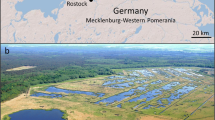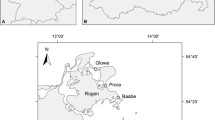Abstract
Four filamentous cyanobacteria, Microcoleusvaginatus, Phormidium tenue,Scytonemajavanicum (Kutz.) and Nostoc sp., and asingle-celled green alga, Desmococcus olivaceus, allisolated from Shapotou (Ningxia Hui Autonomous Region of China), were batchcultured and inoculated onto unconsolidated sand in greenhouse and fieldexperiments. Their ability to reduce wind erosion in sands was quantified byusing a wind tunnel laboratory. The major factors related to cohesion of algalcrusts, such as biomass, species, species combinations, bioactivity, niche,growth phase of algae, moisture, thickness of the crusts, dust accretion(including dust content and manner of dust added) and other cryptogams(lichens,fungi and mosses) were studied. The best of the five species were M.vaginatus and P. tenue, while the best mix wasablend of 80% M. vaginatus and 5% each of P.tenue,S. javanicum,Nostocsp. and D. olivaceus. The threshold friction velocity wassignificantly increased by the presence of all of the cyanobacterial species,while the threshold impact velocity was notably increased only by thefilamentous species. Thick crusts were less easily eroded than thin crusts,while biomass was more effective than thickness. Dust was incorporated bestintoMicrocoleus crust when added in small amounts over time,and appeared to increase growth of the cyanobacterium as well as strengthen thecohesion of the crust. Microbial crust cohesion was mainly attributed to algalaggregation, while lichens, fungi and mosses affected more the soil structureand physico-chemical properties.
Similar content being viewed by others
References
Belnap J. and Gardner J.S. 1993a. Soil microstructure in the soil of the Colorado plateau: the role of the cyanobacterium Microcoleus vaginatus. Great Basin Nat. 53: 40-47.
Belnap J. 1993b. Recovery rates of cryptobiotic crusts: inoculant use and assessment methods. Great Basin Nat. 53: 89-95.
Belnap J. and Gillette D.A. 1997. Disturbance of biological soil crusts: impacts on potential wind erodibility of sandy desert soils in southeastern Utah. Land Degradation and development 8: 355-362.
Belnap J. and Gillette D.A. 1998. Vulnerability of desert biological soil crusts to wind erosion: the influences of crust development, soil texture, and disturbance. J. Arid Environ. 39: 133-142.
Booth W.E. 1941. Algae as pioneers in plant succession and their importance in erosion control. Ecology 22: 22-29.
Bresson L.M. 1992. Studies on micromorphology of soil crusts in temperate zone and arid environments. Advances of Agrology in China 20: 36-39.
Brotherson J.D. and Rushforth S.R. 1983. Influence of cryptogamic crusts on moisture relationships of soil in Navajo National Monument, Arizona. Great Basin Nat. 43: 73-78.
Buttars S.M., St. Clair L.L., Johansen J.R., Sray J.C., Payne M.C., Webb B.L. et al. 1986. Rapid stabilization of fire-disturbed sites using a soil crust slurry: inoculation studies. Reclamation and Revegetation Research 4: 261-269.
Cheshire M.V. 1979. Nature and Origin of Carbohydrates in Soil. Academic Press, London.
Dong G.R., Li C.Z., Jin T., Gao S.Y. and Wu D. 1987. Some results on soil wind-tunnel imitating experiment. Chinese Science Bulletin 32: 297-301.
Duan Z.H., Liu X.M. and Qu J.J. 1995. Study on formation mechanism of soil crust in the Shapotou area. Arid Zone Research 13: 31-36.
Falchini L., Sparvoli E. and Tomaselli L. 1996. Effect of Nostoc (cyanobacteria) inoculation on the structure and stability of clay soils. Biol. Fertil. Soils 23: 346-352.
Feng J.C., Liu L.C., Li J.G., Xiao H.L., Zeng W.B. and Liu C.M. 1996. Formation characteristics of condensation water of sandy soil in southeastern fringe of Tengger Desert and it's ecological environmental significance. Chinese Journal of Desert Research 16 (Suppl.1): 70-75.
Fletcher J.E. and Martin W.P. 1948. Some effects of algae and moulds in the rain crust of desert soils. Ecology 29: 95-100.
Garcia-Pichel F. and Castenholz R.W. 1991. Characterization and biological implications of scytonemin, a cyanobacterial sheath pigment. J. Phycol. 27: 395-409.
Gillette D.A. and Dobrowolski J.P. 1993. Soil crust formation by dust deposition at Shaartuz, Tadahik, S.S.K. Atmosphere Environment 27A: 2519-2525.
Hu M.C., Liu Y.Z., Wu L., Yang Z.T. and Wu D. 1991. A experimental study in wind Tunnel on wind erosion of soil in Korqin Sandy Land. Chinese Journal of Desert Research 11: 22-29.
Hu C.X., Liu Y.D., Song L.R. and Huang Z.B. 2000. Species composition and fine distribution of algae in semi-desert algal crusts. Chinese Journal of Applied Ecology 11: 61-65.
Huang Z.B., Liu Y.D., Paulsen B.S. and Klaveness D. 1998. Studies on polysaccharides from three edible species of Nostoc (cyanobacteria) with different colony morphologies: Comparison of monosaccharide compositions and viscosities of polysaccharides from field colonies and suspension cultures. J. Phycol. 34: 962-968.
Johansen J.R. 1993. Cryptogamic crusts of semiarid and arid lands of North America. J. Phycol. 29: 140-147.
Liu Y.D. and Ley S.H. 1993. On soil algae and their physiological ecology. Acta Hydrobiologica Sinica 17: 272-277.
Liu Y.D., Song L.R., Shen Y.W., Li D.H., Hu C.X., Huang Z.B. et al. 2001. Potential of terrestrial microalgae and cyanobacteria in environmental technology. In: Kojima H. and Lee Y.K. (eds), Photosynthetic Microorganism in Environmental Biotechnology. Springer, Hong Kong, pp. 195-216.
Liu Y.Z., Dong G.R. and L C.Z. 1994. A study on the factors in-fluencing soil erosion through wind tunnel experiments. Chinese Journal of Arid Land Research 7: 359-367.
Loope W.L. and Gifford G.F. 1972. Influence of a soil microfloral crust on select properties of soils under pinyon-juniper in southeastern Utah. J. Soil Wat. Conser. 27: 164-167.
Martin J.P. 1971. Decomposition and binding action of polysaccharides in soil. Soil Biol. Biochem. 3: 33-41.
Maxwell C.D. and McKenna Neuman C. 1994. Photoantotrophs and microaggregation of sand in a freshwater beach-dune complex: implication for sediment transport by wind. Soil Biol. Biochem. 26: 221-233.
McKenna Neuman C., Maxwell C.D. and Boulton J.W. 1996. Wind transport of sand surface crusted with photoautotrophic microorganisms. Catena 27: 229-247.
Metting B. 1981. The systematics and ecology of soil algae. The Botanical Review 47: 195-312.
Metting B. 1986. Population dynamics of Chlamydomonas sajao and its influence on soil aggregate stabilization in the field. Appl. environ. Microbiol.: 1161-1164.
Metting B. and William R.R. 1983. The influence of a microalgal conditioner on selected Washington soil: an empircal study. Soil Sci. Soc. Am. J. 47: 682-685.
Moore B.G. and Tischer R.G. 1964. Extracellular polysaccharides of algae: effect on life-support systems. Science 145: 586-588.
Mucher H.J., Chartres C.J., Tongway D.J. and Greene R.S.B. 1988. Micromorphology and significance of surface crusts of soils in rangelands near Cobar, Australia. Geoderma 42: 227-244.
Navarini L., Cesaro A. and Ross-Murphy S.B. 1992. Viscoelastic properties of aqueous solutions of an exocellular polysaccharide from cyanobacteria. Carbohydrata. Polymers 18: 265-72.
Painter T.J. 1993. Carbohydrate polymers in desert reclamation: the potential of microalgal biofertilizers. Carbohydrate Polymers 20: 77-86.
Pendleton B.K. and Warren S.D. 1998. Pelletized cyanobacterial soil amendments: laboratory testing for survial, escapability, and nitrogen fixation. Arid Soil Research and Rehabilitation 12: 165-178.
Rogers S.L. and Burns R.G. 1994. Changes in aggregate stability, nutrient status, indigenous microbial population, and seeding emergence following inoculation of soil with Nostoc muscorum. Biol. Fertil. Soils 18: 209-215.
Sala O.E. and Lauenroth W.K. 1982. Small rainfall events: an ecological role in semiarid region. Oecologia 53: 301-304.
Shields L.M. and Durrell L.W. 1964. Algae in relation to soil fertility. Bot. Rev. 47: 195-312.
St. Clair L.L., Johansen J.R. and Webb B.L. 1986. Rapid stabilization of fire-disturbed sites using a soil crust slurry: inoculation studies. Reclamation and Revegetation Research 4: 261-269.
Whitton B.A. 2000. Soils and rice-fields. In: Whitton B.A. and Potts M. (eds), The Ecology of Cyanobacteria: Their Diversity in Time and Space. Kluwer Academic Publishers, Dordrecht, The Netherlands, pp. 233-255.
Williams J.D., Dobrowolsk J.P., West N.E. and Gillette D.A. 1995a. Microphytic crust influence on wind erosion. Transactions of the ASAE 38: 131-137.
Williams J.D., Dobrowolsk J.P. and West N.E. 1995b. Microphytic crust influcence on interrill erosion and infiltration capacity. Transactions of the ASAE 38: 139-146.
Zhou Zh.G., Zhong G., Liu Z.L. and Chen Z.J. 1995. Soil algae and their effect on stability of soil aggregates. J. Phycol. (Suppl.): 99.
Author information
Authors and Affiliations
Rights and permissions
About this article
Cite this article
Hu, C., Liu, Y., Song, L. et al. Effect of desert soil algae on the stabilization of fine sands. Journal of Applied Phycology 14, 281–292 (2002). https://doi.org/10.1023/A:1021128530086
Issue Date:
DOI: https://doi.org/10.1023/A:1021128530086




